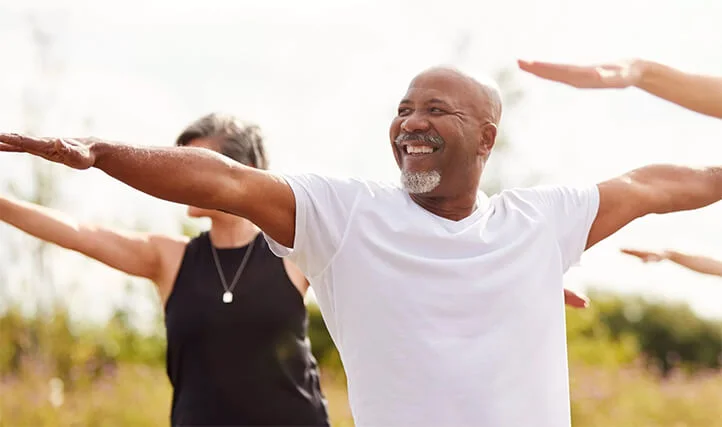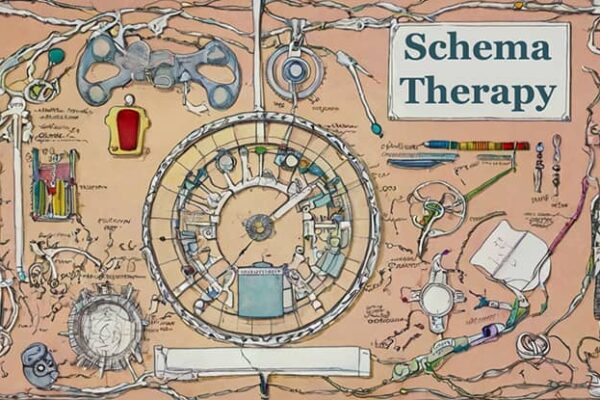Body-Oriented Therapy is a form of psychotherapeutic work that focuses on the deep connection between the body and mind. This holistic approach takes into account that physical sensations, patterns of tension, and body movements are closely intertwined with our emotions, thoughts, and life experiences. The goal of body-oriented therapy is to help people release stagnant emotions, psychological trauma, and blocks sealed in the body, thus achieving greater self-understanding, wholeness, and well-being.
Body-oriented therapy is based on the idea that the body stores “somatic imprints” of our experiences, which manifest in the form of chronic muscle tension, movement restrictions, breathing disturbances, and other physical symptoms. By recognizing and releasing these somatic manifestations, people can resolve deeply rooted emotional issues that often resist traditional forms of psychotherapy.
The main goals of body-oriented therapy include:
- increasing body awareness and its sensations;
- releasing chronic muscle tension and emotional blocks;
- freeing oneself from traumatic memories and experiences;
- strengthening the connection between body and mind;
- improving self-acceptance and self-esteem;
- developing greater flexibility and freedom in body movements.
The benefits of body-oriented therapy are numerous and include reducing stress, anxiety, and depression, relieving chronic pain and muscle tension, improving body flexibility and mobility, understanding one’s emotions and reactions, as well as enhancing overall well-being and vitality.
One of the unique advantages of body-oriented therapy is its ability to reach subconscious layers of the psyche through work with bodily sensations and movements. This allows for transformation at a deeper, more implicit level, which is often difficult to achieve using only verbal psychotherapy.

The History of Body-Oriented Therapy
The roots of body-oriented therapy can be traced back to ancient Eastern practices such as yoga, Tai Chi, various forms of meditation, and healing arts, which emphasize the importance of body awareness, the unity of body and mind, and the use of movement and breathing to achieve physical and mental balance. However, modern body-oriented therapy as a distinct psychotherapeutic modality emerged in the 20th century through the pioneering work of Wilhelm Reich and his theory of bioenergetics.
The Contribution of Wilhelm Reich and Bioenergetics
Wilhelm Reich, an Austrian psychoanalyst and scientist, made a significant contribution to the development of body-oriented therapy with his revolutionary theory of bioenergetics. He believed that emotional energy flows through the body in the form of “biological energy” and that emotional problems manifest as muscle tension and blocks, which hinder the free flow of this energy.
Reich developed a series of physical exercises and postures aimed at releasing these energetic blocks and helping people gain greater mobility, vitality, and spontaneity. His work laid the foundation for the use of physical exercises, breathing, and movement in a psychotherapeutic context to release stagnant emotions and energy.
Despite his controversial image and persecution, Reich made an invaluable contribution to the understanding of the importance of working with the body in psychotherapy. His ideas inspired subsequent generations of psychotherapists and researchers to further develop body-oriented approaches.
Modern Directions in Body-Oriented Therapy
Since then, body-oriented therapy has branched out into numerous different methods and approaches, each with its own unique techniques and emphases, but all based on the fundamental principle of the body-mind connection. Here are some of the most well-known modern branches:
- Bioenergetics – a branch most closely related to Wilhelm Reich’s original work, using physical exercises, breathing techniques, and muscle tension.
- Body-oriented psychotherapy (TOP) – combines traditional talk therapy with body practices such as mindful touch, movement, and breathing.
- Hakomi – a form of somatic psychotherapy using gentle touch and verbal instructions to release emotional blocks in the body.
- Rolfing (structural integration) – a method of manual therapy focusing on relieving pain, improving posture, and maintaining overall well-being through gentle stretching, pressure, and massage.
- Somatic trauma therapy – applies body-oriented techniques to process and release traumatic memories and reactions stored in the body.
- Dance movement therapy – uses natural movements and dance as a means of self-exploration, emotional expression, and life experience.
Additionally, there are many other methods, such as Moshe Feldenkrais’s method of awareness through movement, authentic movement, continuum, and others. What they all share is the recognition of the deep connection between the body, mind, and emotions.

Principles of Body-Oriented Therapy
The principles of body-oriented therapy take into account the deep interconnection between the physical state of the body, emotional well-being, and psychological health. They are based on the understanding that the human body represents a holistic system in which each part affects the others.
The Body-Mind Connection
One of the key principles of body-oriented therapy is the recognition of the inseparable connection and mutual influence between the body and mind. Our physical sensations, tension patterns, movements, and breathing are closely intertwined with our emotions, thoughts, beliefs, and overall life experience.
For example, stress or anxiety triggers a cascade of physical changes in the body, such as increased heart rate, shallow breathing, and tension in the chest and abdomen. Conversely, physical changes, such as an uncomfortable posture or movement restrictions, can contribute to the emergence of negative emotions and thoughts.
Body-oriented therapy recognizes that the body not only reflects our internal states but also actively shapes them. By releasing chronic muscle tension and restrictions, we can access deeply rooted emotional problems and address them on a somatic level.
Releasing Emotional Blocks Through the Body
According to the principles of body-oriented therapy, unresolved emotions, traumatic experiences, and psychological issues leave “imprints” in the body in the form of muscle tension, movement restrictions, breathing disturbances, and other somatic manifestations, which in turn support and amplify psychological problems, creating a vicious cycle.
Body-oriented therapy assumes that by becoming aware of these somatic manifestations and working with them intentionally, stagnant emotions can be released, and traumatic memories and psychological issues can be resolved. This is achieved by activating “resourceful” states associated with relaxation, openness, and free body movement.
Thus, working with the body serves as a kind of “gateway” to access unconscious layers of the psyche and triggers self-healing processes at a deep, implicit level.
Increasing Body Awareness
An important part of body-oriented therapy is developing a deeper awareness of one’s body, its sensations, tension patterns, movements, and breathing. Through practices of mindful body scanning, meditation, and other exercises, clients learn to notice subtle bodily signals that previously went unnoticed.
Increasing body awareness helps to better understand emotional and physical reactions, recognize stress or trauma triggers, and establish a closer connection between body and mind. This enhances the ability to self-regulate emotional states and provides more choices for responses to various situations.
Many body-oriented therapy practices are also aimed at developing greater flexibility, relaxation, and free movement in the body, which is associated with feelings of openness, spontaneity, and vitality. Based on this, body awareness becomes not only a tool for healing but also a path to self-realization and a happy life.

Types of Body-Oriented Therapy
There are many different types and modalities of body-oriented therapy, each with its unique approaches, techniques, and emphases. Here’s a brief overview of some of the most common forms:
Bioenergetics
Bioenergetics is one of the foundational forms of body-oriented therapy, directly derived from the work of Wilhelm Reich. It involves a series of physical exercises, postures, and breathing practices aimed at releasing stagnant “biological energy” and emotional blocks from the body.
The main techniques of bioenergetics include “charging” exercises to activate and become aware of certain parts of the body, stretching and tensing various muscle groups, as well as working with emotional expression through the body using sounds, movements, and postures.
The goal of bioenergetics is to help clients express themselves more freely and naturally through their bodies, to develop greater vitality, spontaneity, and access to their true feelings and needs.
Body-Oriented Psychotherapy
Body-oriented psychotherapy (BOP) combines traditional methods of talk therapy with direct use of body techniques, such as mindful touch, movement, breathing, and posture work. This allows clients to better understand and resolve their psychological issues and life questions through a deeper connection with their bodily experience.
In BOP sessions, the therapist may use touch to release muscle tension, suggest various postures and body movements to work through specific emotions or situations, and use directed breathing and bodily awareness to ground and integrate new experiences.
BOP is often applied to treat conditions such as post-traumatic stress disorder, anxiety disorders, clinical depression, relationship issues, and more. Its aim is to promote holistic healing and personal growth through conscious work with bodily processes.
Hakomi
Hakomi is a form of somatic (body-oriented) psychotherapy developed by Ron Kurtz. It uses gentle touch and verbal guidance to help clients recognize and explore their deep-seated beliefs, emotional patterns, and “organizing principles” that shape their perception of reality and behavior.
In the Hakomi process, the therapist gently touches specific parts of the client’s body and invites them to focus on the sensations and images that arise. Through mindful exploration of these somatic manifestations, the client can access their unconscious beliefs and discover new ways of responding to their environment.
The Hakomi method is based on principles of safety, mindfulness, and acceptance. Its goal is to foster greater flexibility, openness, and the ability to heal oneself by working with the “soft side” of the psyche, which manifests through the body.
Rolfing
Rolfing, also known as structural integration, is a form of body-oriented therapy developed by Ida Rolf. It focuses on manipulating and stretching connective tissues (fascia) to improve the structural integrity, alignment, and movement of the body.
In a series of 10 sessions, the Rolfer uses specific stretching techniques to release restrictions in the fascial system and rebalance the distribution of muscle tension. This leads to improved posture, joint mobility, and overall biomechanical efficiency of the body.
In addition to physical benefits, clients often report positive psychological effects after Rolfing, such as improved self-perception, overall emotional well-being, self-confidence, and tactile awareness.
Rolfing is particularly beneficial for individuals with chronic pain, mobility limitations, poor posture, or issues related to psychological trauma. It can also be a valuable complement to other forms of body-oriented or talk therapy.
Somatic Trauma Therapy
Somatic trauma therapy applies body-oriented methods to treat post-traumatic stress disorder (PTSD) and other trauma-related conditions. The main idea is that traumatic experiences are stored in the body’s memory in the form of dissociative states, muscle tension, and disrupted response patterns.
Methods of somatic trauma therapy, such as Peter Levine’s somatic experiencing, aim to safely resolve these trapped traumatic energies through bodily awareness and the gradual release of tension.
The therapist uses various exercises to track bodily sensations, resourceful states, and controlled release of trauma energy. An important aspect here is creating a safe atmosphere for the client.
Somatic trauma therapy is often more effective than traditional methods, as it allows trauma to be processed on a trusted, unconscious level through the body. It helps integrate the traumatic experience and return to adaptive functioning.
Dance/Movement Therapy
Dance/movement therapy uses natural movement and dance as tools for self-exploration and expression of inner emotional experiences. It is based on the idea that the body is an embodiment of the soul, and movement is a direct expression of feelings that are often difficult to articulate with words.
In dance/movement therapy, clients are encouraged to engage in free, improvisational movement, allowing the body to lead and express what is hidden in the unconscious. The therapist may also offer specific exercises, themes, or music to stimulate certain emotional states and processes.
Dance/movement therapy is beneficial for those who have difficulty with verbal self-expression, such as people with psychological trauma, mental disorders, or developmental issues. It is also used to enhance self-esteem, develop creativity, improve interpersonal skills, and increase overall vitality.
In addition to these primary forms, there are other approaches, such as the Feldenkrais method, the Alexander technique, authentic movement, and more. All are united by the common recognition of the healing power inherent in the conscious use of the body.

How Does Body-Oriented Therapy Work?
Although specific methods may vary between different types of body-oriented therapy, the overall process includes several key stages.
Initial Consultation and Assessment
The process usually begins with an initial consultation, during which the therapist gathers detailed information about the client’s history, complaints, goals, and expectations for therapy. At this stage, an initial analysis of the client’s current condition is also conducted, which may include an assessment of posture, movements, breathing, and areas of muscle tension in the body.
This information is used to determine the most appropriate approach and develop an individualized therapy plan. The therapist also discusses any risk factors or contraindications that should be taken into consideration.
Creating a Safe and Supportive Environment
One of the key factors for the success of body-oriented therapy is creating an atmosphere of safety, trust, and acceptance between the client and therapist. Many people have accumulated significant muscle tension due to traumatic experiences or unmet basic needs in childhood. Therefore, it is essential for the therapist to demonstrate empathy, care, and unconditional positive regard.
At the beginning of the work, the therapist usually focuses on building a therapeutic relationship and developing a sense of safety for the client through proper boundaries, active listening, and maintaining confidentiality. Special exercises for establishing body awareness and grounding in the present moment may also be used.
Exercises and Practices
After establishing a safe and supportive environment, the therapist begins to use various exercises and practices to achieve the goals of body-oriented therapy according to the chosen approach. This may include:
- physical exercises and postures (from bioenergetics, yoga, or other sources);
- breathing practices to deepen body awareness;
- mindful movements and dance for emotional expression;
- gentle touch and manipulations to release tension;
- verbal guidance to redirect attention to bodily sensations;
- the use of visualization and imagination to access unconscious processes;
- home practices to integrate experiences from the session.
The overall goal of these exercises is to help the client become aware of their deep bodily patterns, emotional blocks, and engage in the process of self-discovery and healing. Here, the therapist acts as a moderator, guiding and supporting these processes.
Integration and Further Work
As the therapeutic process progresses, clients often report significant shifts and insights at the level of body-mind. Through bodily experiences during the sessions, they begin to grow and root new ways of being and responding.
An important part of the work becomes integrating these new states and consciously transferring them into daily life. The therapist may provide specific exercises and practices for home to solidify the newly gained abilities. Keeping a journal or notes to track the process may also be helpful.
For many people, body-oriented therapy becomes a path of continuous self-discovery and development over time. As psychological blocks dissolve, access to deeper layers of awareness and transformation becomes available. And this exciting journey inward never ends.
The Role of the Therapist
The primary role of the therapist in body-oriented therapy is to be a compassionate companion and guide on this journey. A good body therapist has a deep understanding of the principles and methods for using the body to access the implicit layers of the psyche. But even more important are qualities such as empathy, attentiveness, care, and the ability to create a safe space.
A qualified therapist can see through the symptoms and behavioral manifestations to the deeper core issues and unresolved matters the client needs to address. They help the client develop greater awareness and openness to their experience without judgment or evaluation.
The relationship between the therapist and client, based on trust, safety, and mutual respect, is crucial to the success of body-oriented therapy. The client must feel accepted as they are, to loosen control and immerse themselves in the deep processes of holistic healing.

Advantages and Applications of Somatic Therapy
Somatic therapy can provide significant benefits for a wide range of people with various problems and conditions. Here are some of the most common areas of its application:
Reduction of Stress and Anxiety
Conscious work with breathing, movement, relaxation, and the release of muscle tension can significantly lower stress levels, anxiety, and overall nervous agitation. Regular somatic practices help activate the parasympathetic nervous system, which is responsible for relaxation.
Research shows that somatic therapy is effective in treating various anxiety disorders, helping individuals better cope with stressful situations and anxiety. It is often used as an adjunct therapy for chronic pain caused by muscle tension.
Improvement of Self-Esteem and Self-Acceptance
One of the valuable advantages of many forms of somatic therapy is the development of a more positive body image and an increase in self-esteem. In-depth work with the body and its sensations fosters better acceptance and understanding of one’s physical form.
Mindful movement practices, dance, and self-expression through the body are linked to increased self-confidence and greater openness to new experiences. As individuals free themselves from the shackles of self-criticism, guilt, and shame, they begin to enjoy their natural grace, strength, and beauty of movement.
Improvement of self-esteem through body work is especially valuable for those who have experienced psychological trauma, humiliation, and unmet basic needs in childhood.
Resolution of Psychological Trauma
Somatic therapy can be extremely effective for resolving traumatic experiences and alleviating symptoms associated with post-traumatic stress disorder (PTSD). Since traumatic memories are encoded in the non-verbal areas of the brain, traditional talk therapy often proves inadequate for processing them.
Somatic approaches allow for the safe processing of unspoken traumatic energy using body awareness, resource states, and gradual release of physical tension.
Somatic therapy helps individuals reprocess trauma responses of “fight, flight, or freeze” generated at the body level by the brain during a traumatic event. By releasing “stuck” energy in the body, clients begin to relate more calmly to memories of the traumatic experience.
Improvement of Connection with One’s Emotions and Needs
Many people in modern society feel “disconnected” from their true emotions and bodily sensations as they focus on constant mental activity and productivity at the expense of deep contact with their inner world.
Somatic therapy helps restore this lost connection, teaching individuals to trust their experiences and be guided by them. Through body awareness practices, clients learn to recognize subtle signals of physical sensations and emotions that are often ignored in daily life. They develop the ability to notice when tension, fear, or other feelings arise before they escalate into full-scale reactions.
By reconnecting with the language of the body, individuals gain deeper access to their true desires, values, and needs. This allows them to make more conscious choices in their decisions, live a more meaningful and purposeful life, and stay true to their inner essence.
Many clients report that somatic therapy has helped them transition from a constant “autopilot” mode of functioning to full presence and awareness in each moment.
Overcoming Emotional Stagnation and Stuckness
For some individuals, emotional contradictions and internal conflicts remain unresolved for a long time, despite years of traditional psychotherapy. In such cases, a somatic approach should be tried, which can offer a different path to progress.
Working directly with the bodily manifestations of these internal contradictions, such as muscle tension, movement restrictions, or breathing disruptions, helps open access to deeper, subconscious layers of the psyche. What has stubbornly been blocked at the mental level may resolve through direct involvement of the body.
Techniques such as bioenergetic exercises for expressing opposing impulses through the body or using controlled movements and postures in Hakomi allow individuals to safely process these stuck energies and create new neural connections.
Thus, somatic therapy often proves crucial for those struggling with self-understanding, emotional flexibility, and realizing their potential. It awakens the capacity for renewal and personal growth.
Improvement of Sexuality and Intimacy
Our body is home not only to emotions and psychological trauma but also to our sexuality and ability to experience deep intimacy. Many problems in these areas stem from muscle tension, energetic blocks, and negative beliefs associated with the body.
Somatic therapy helps address these deep-seated issues by releasing chronic tension in the pelvic area, abdomen, and heart. By increasing awareness and comfort in their bodies, individuals often gain a more open and holistic experience of their sexuality.
Some forms of somatic therapy work directly with sexual and intimate themes, using specific exercises to build trust, boundaries, and deep presence.
By helping restore the lost connection between the body, heart, and sexuality, somatic therapy transforms the realm of intimate relationships, bringing more passion, love, and satisfaction into human life.
Personal Growth and Self-Actualization
In addition to addressing specific psychological issues, somatic therapy also aids in personal growth and self-actualization. By working towards greater awareness, life energy, and flexibility, individuals gain the opportunity to view themselves and their possibilities from a different perspective.
Liberation from old limiting emotional and physical patterns opens space for the emergence of a new, more authentic self. Embracing all aspects of one’s being through practices of presence and embodiment can radically change one’s sense of identity and relationship to life.
Work with movement and bodily expression often awakens creative energy and enhances the sense of life flow. Dance and meditative practices become forms of holistic self-expression and self-exploration.
For many, somatic therapy serves as an integral part of a larger process of self-discovery, personal integration, and spiritual growth, traversing all levels of existence—physical, emotional, mental, and spiritual.

Contraindications and Warnings
Although somatic therapy is generally safe and beneficial for most people, there are some contraindications and situations where caution is required. Therefore, it is important to always consult with qualified professionals before beginning any form of body work.
When Somatic Therapy May Be Contraindicated?
Somatic therapy may be contraindicated or require special precautions in the following cases:
- Recent surgeries, injuries, or abrupt changes in medical condition.
- Certain acute or chronic physical conditions (osteoporosis, fibromyalgia, multiple sclerosis, etc.).
- Mental disorders (psychoses, severe depression with suicidal tendencies).
- Eating disorders (anorexia, bulimia).
- PTSD with frequent dissociative states and a lack of safety.
In these situations, special precautions may be needed, along with the adaptation of methods or the combination of somatic therapy with other forms of work.
Somatic therapy is also not recommended for patients unable to provide informed consent to participate, such as in some forms of dementia, intellectual disabilities, or under the influence of psychoactive substances.
Importance of Choosing a Qualified Therapist
The effectiveness and safety of somatic therapy largely depend on the qualifications, experience, and professionalism of the practicing therapist. When choosing a somatic therapist, it is crucial to ensure they have proper training, certification, and clinical practice in the chosen approach.
Adhering to ethical standards and boundaries is also vital. Clients must feel completely safe and confident that their personal space and dignity will be respected throughout the process.
A good somatic psychotherapist demonstrates compassion, empathy, and a commitment to creating a safe, supportive environment. They possess a deep understanding of the subtleties of applying somatic methods and the ability to respond sensitively to the individual needs and reactions of each client.

Conclusion
Somatic therapy offers an effective and unique path to healing, self-discovery, and personal growth through conscious work with the body. By recognizing the deep connection between physical sensations, body movements, and inner psychological processes, these approaches open access to layers of the psyche that are typically beyond the reach of traditional verbal methods.
From bioenergetics and structural integration to somatic trauma therapy and dance therapy, the numerous modalities of somatic therapy are united by a shared understanding of the healing potential contained within the language of the body. By releasing stagnant emotions, psychological traumas, and limiting beliefs embedded in the body, individuals begin to express their true essence more freely.
The journey of somatic therapy is one of diving into deep presence in the moment, integrating scattered parts of oneself, and achieving a more complete sense of life wholeness. Embracing all aspects of one’s embodied being opens new horizons of self-understanding, self-expression, and creativity.
As more individuals become aware of the importance of a holistic approach to healing and well-being, somatic therapy is likely to continue gaining popularity. Further scientific research will also help strengthen the evidence base for its effectiveness.
In the future, we can expect the development of new forms of somatic therapy, as well as the integration of these methods with the latest advancements in the fields of neurobiology, augmented reality technologies, and even psychedelic therapy. Regardless of the specific directions, body therapy will undoubtedly continue to play an important role in maintaining holistic physical, psychological, and spiritual well-being.
Recommended Literature
- “Sensorimotor Psychotherapy: Interventions for Trauma and Attachment” by Pat Ogden and Janina Fisher. This book presents an innovative approach to treating psychological trauma and related disorders through the interaction between body and mind.
- “Waking the Tiger: Healing Trauma” by Peter A. Levine offers a new perspective on understanding and treating psychological trauma using the principles of somatic psychotherapy to alleviate symptoms and achieve complete healing.
- “The First Year and the Rest of Your Life: Movement, Development, and Psychotherapeutic Change” by Ruella Frank explores how fundamental motor interactions between infants and parents become a jointly constructed experience underlying psychological development.
- “Emotional Anatomy: The Structure of Experience” by Stanley Keleman presents a theory that human emotions are rooted in bodily sensations and emphasizes the importance of the body’s experience in understanding emotional responses.
- “Bioenergetics: The Revolutionary Therapy That Uses the Language of the Body to Heal the Problems of the Mind” by Alexander Lowen asserts that a lack of energy is the result of chronic muscular tension, a state caused by the suppression of feelings. The book discusses how to relieve this tension through body work using bioenergetic exercises that restore the ability to live a rich and fulfilling life.




